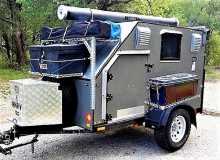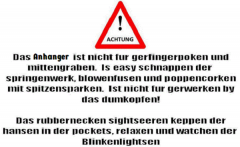 by working on it » Mon Oct 04, 2021 6:49 am
by working on it » Mon Oct 04, 2021 6:49 am
* I've always inflated ST bias-ply tires to max cold pressures to ensure enough sidewall stiffness for the trailer's load, whether on single or dual axle trailers. When I used ST radials (on the dual axle trailers), I did the same, since I was carrying loads at or near the load rating of the tires and/or axles. I've never used P tires on a trailer (though the 4.5x12 ?? trailer utility I recently acquired has them), and will not use them for heavy loads, anyway.
* I now use LT tires on my 4x8, which is heavy for its' size, at 2225 lbs. loaded. I switched from ST bias plies, with stiff sidewalls, so to maintain stiff sidewalls on the LT's, I inflate them to 50 psi, their max cold pressure. Rated for 1520 lbs each, they can support 3040 lbs (37% more than the load, which rises each season), and I like the added safety margin (at least 25% is my standard goal). There is no bounce from the full pressure, as I've made an always active bump stop/cushion that absorbs jolts. Since my 3500 lb axle has no camber, and the 3000 lbs springs can easily handle the trailer weight, the tires maintain a flat footprint on the road.
* I also run LT tires on my '04 Chevy 2500HD tow vehicle, which has been modified to carry/tow 12000 lbs (I carry about 1000 lbs in the bed, at all times). I ran 50psi in front/80psi in the rear when pulling my loaded race car trailer, 48psi front/72psi rear for my 4x8. I've only reduced the pressure to 45/70 once, when I had to drive the 2WD truck on snow/ice for 200+ miles (I couldn't tell if any traction advantage was gained).
* I really don't see the need to reduce air pressure, for a better ride on most US roads, on a standard-sized small recreational trailer, if weight/balance/spring characteristics are in harmony. On a leaf spring suspension, the spring rate must be within the normal range of the loads carried, with some sort of shock absorber to help handle the ride motion. On torsion-springed axles, that motion is somewhat controlled by the axle itself, though it must be rated nearly the same as the loaded trailer to handle ride motion without bottoming-out, or bouncing. Timbren axles are much the same as torsion axles, IMO, so the operator/owner must get the right spring rating, or at least get close. Trailing arm suspensions, with adjustable air springs or coil-overs are the best choice for variable loading or road conditions, but very expensive to get right, and not usually found on small recreational trailers like most built on this forum.
* Under-inflated tires build excess heat, and are subject to blow-outs, or tread loss. I'd rather chance some jarring of the trailer contents, a bouncy ride, or uneven treadwear, from fully-inflated tires, than catastrophic tire failure from under-inflation.
2013 HHRv "squareback/squaredrop", rugged, 4x8 TTT, 2225 lbs- *3500 lb Dexter EZ-Lube braked axle, 3000 lb.springs, active-progressive bumpstop suspension
- *27 x 8.5-14LT AT tires (x 3) *Weight Distribution system for single-beam tongue
- *100% LED's & GFCI outlets, 3x fans, AM/FM/CD/Aux. *A/C & heat, Optima AGM, inverter & charger(s)
- *extended-run, on-board, 2500w generator *Coleman dual-fuel stove & lantern, Ikea grill, vintage skillet
- *zinc/stainless front & side racks *98"L x 6" diameter rod & reel carrier tube on roof






 Danny
Danny 